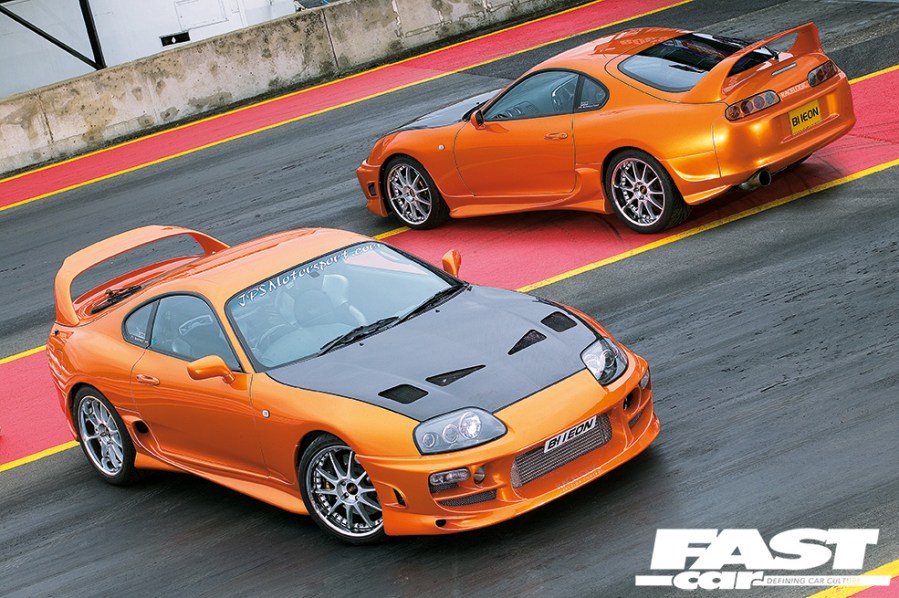Back in 2005, having a 1000bhp+ Mk4 Supra wasn’t nearly as common as it is today. We’ve pulled Leon Green’s 1050bhp MK4 Supra feature from back in 2005 to marvel over what was a groundbreaking £200k build.
With 1050bhp under his carbon bonnet, it’s no wonder Leon Green’s infamous JPS Motorsport Mk4 Supra pounds the 1/4 mile in 10.02sec…
Leon Green’s Supra growls along the Santa Pod drag strip. Although he’s driving the car painfully slowly, the photographer’s Mondeo is flat-out in the first three gears just to keep up. For a brief moment the sun shines hard through the thick covering of cloud above and the pearl orange paintwork shimmers back in approval. He’s not doing any runs up the best-known drag strip in the UK today, but it’s become the spiritual home of both Leon and his fearsome Toyota Supra Mk4.
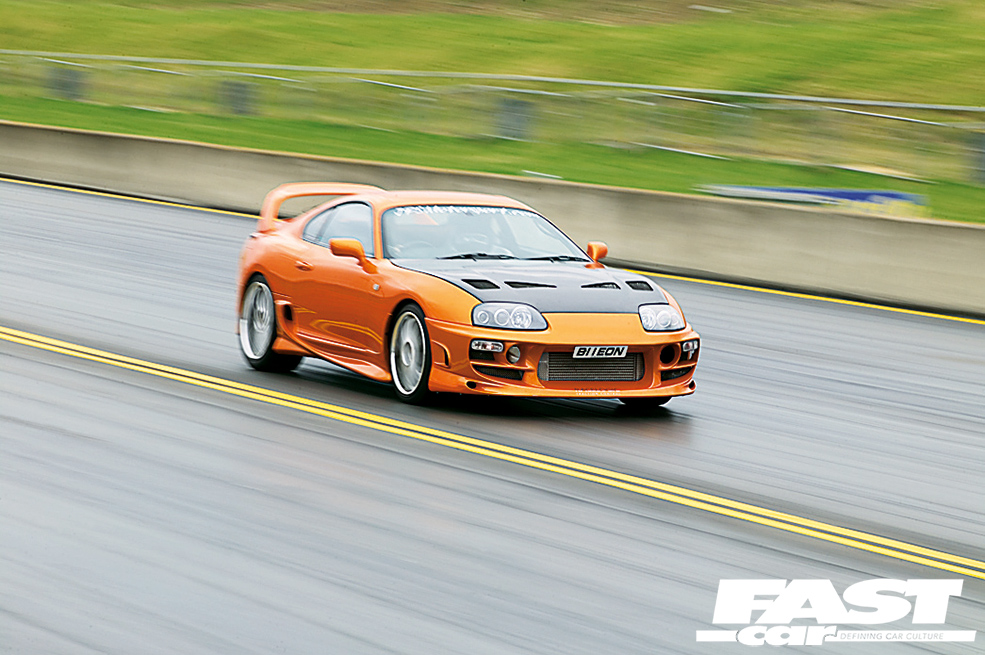
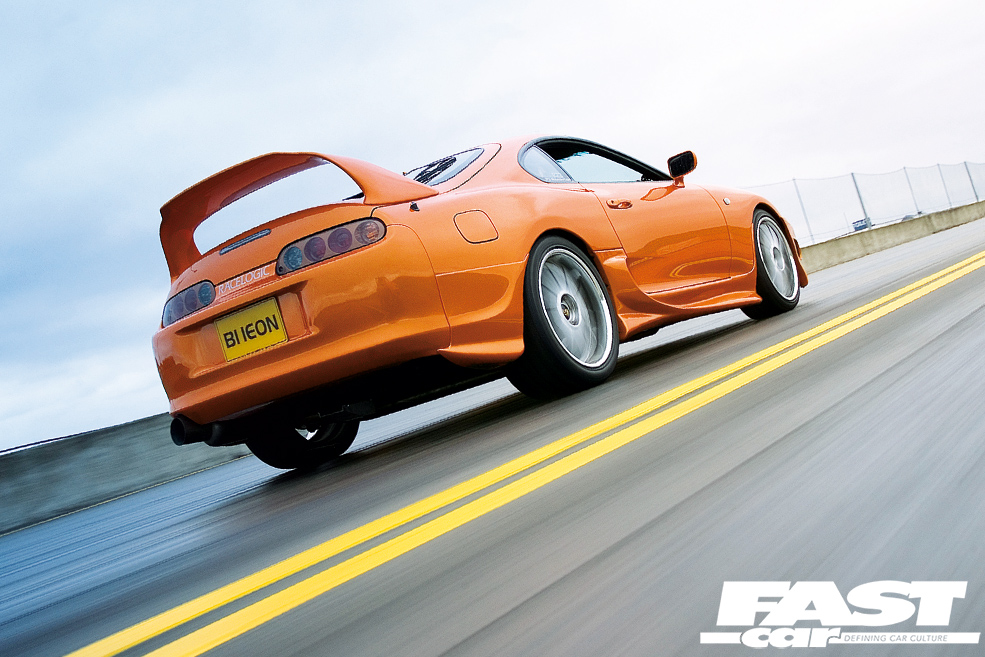
“God of the Pod”
Just a couple of weeks ago, Leon blasted past some stiff opposition to become the ‘God of the Pod’ at the Redline Rumble. Leon’s tuning firm, Japanese Performance Specialists (JPS Motorsport), rebuilt the engine just in time for the competition. They had it running on Friday, ran the engine in on Saturday and Leon raced it to victory on Sunday! The only past winners of this competition are the Norris Designs Evo VII RS, and the Calder Racing Developments Supra, both of which have run over 200mph. So by winning the competition, Leon has gained membership of a very exclusive club, and earned the immense respect that goes with it.
After flicking through some images of the event in issue two of J-Tuner, we find a shot of Leon doing just that while beating the 200mph 4WD Fensport Corolla off the line. After years of development, Leon’s Supra is starting to take some serious scalps on the drag strip.
On his winning run, Leon managed an amazing 10.02sec at 145mph! “It‘s always been my goal to run a 9sec, fully weighted,” remarks Leon. “From the stands, people might think the car is fully stripped, but in reality I think all the bolt-on parts have made the car heavier than standard! If it‘s lighter than 1700kgs I’ll be surprised.” This certainly makes Leon’s achievements even more remarkable. It has brutal horsepower at the top end of the strip, and the ability to fire off the line with urgent efficiency.
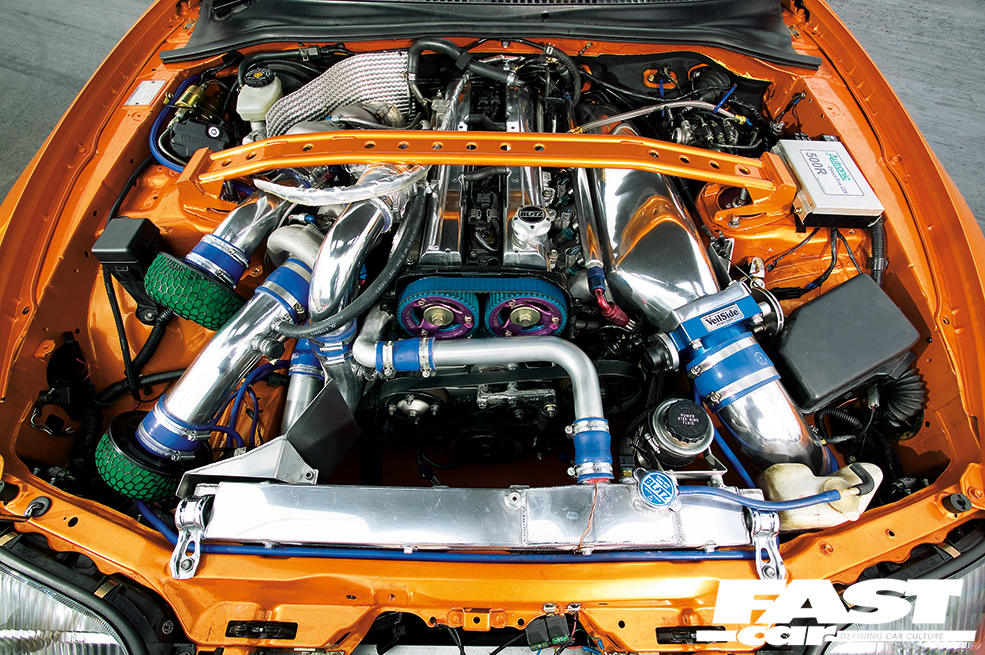
JPS Mk4 Supra fast road setup
“It’s the result of years of R&D on the car” explains Leon, before highlighting the key modifications needed to aid traction off the line. On the day of the shoot, the Supra was fitted with 19in Blitz Technospeed rims and Tein adjustable suspension. This is essentially his ‘fast road’ setup, but for drag racing, Leon swaps to Bogart 11x15in wheels with BF Goodrich tyres, and an HKS drag suspension setup. In drag spec, a quick burnout warms the rubber for optimum traction before staging. When the lights go green, Leon stamps on the loud pedal and the weight is shifted to the rear of the car, an effect emphasised by the soft HKS rear suspension. As a result the weight transfer pushes most of the mass over the rear wheels, providing optimum traction.
While this is happening, a shot of nitrous is fired into the heavily-built engine which includes forged rods and pistons, a strengthened crank and a pair of very special turbos. Leon uses the wet nitrous setup as a form of anti-lag, injecting a mixture of fuel and nitrous oxide into the cylinders to increase engine revs rapidly, helping spool up the twin turbos. He’s keeping the exact amount of nitrous he injects a secret, but it’s certainly an effective dose. The turbos themselves are special units which JPS Motorsport are developing with Turbo Technics. There have been many different turbo setups on the car, which has had £170-200k spent on it since Leon bought it in 1996.
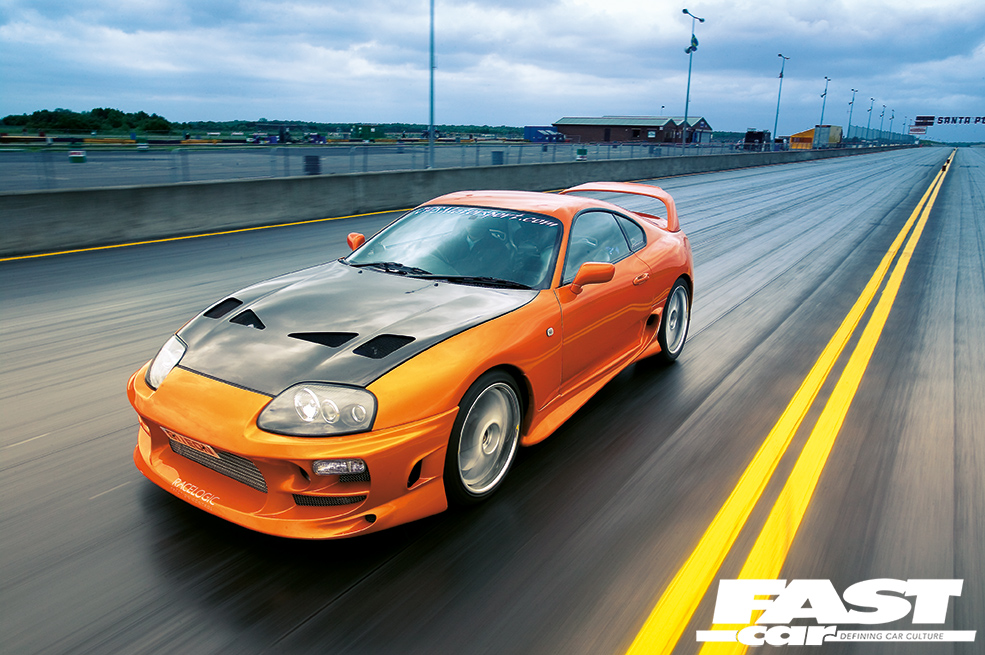
Choosing turbochargers for the Mk4 Supra
“I’ve had stage one, two and three turbos on the car, before moving on to HKS 2835s and then HKS 3040s,” explains Leon, describing around seven years of setup changes. With so much money invested in the car, why has he not gone for a huge single turbo? “There are two answers to that question: the first is that it left the factory as a twin-turbo, so I‘d like it to remain that way. The second is that I‘m not prepared to put up with the flat off-boost performance associated with huge singles.”
“I was pretty happy with the performance of the HKS 3040s originally,” Leon continues, “but with the help of Turbo Technics, we’re trying to achieve better response and gain a bit more power at the top end, too. I know it’s difficult to achieve both, but that’s what we’re trying to do.” With brand new Turbo Technics units that look physically similar to the 3040s, Leon has achieved his goal: “We recorded 4psi of boost at 4000 rpm with the 3040s, but 10psi at 4000 rpm with our new turbos.” On the strip, that means more power, sooner, and lower times. Incidentally, the dyno graph also showed a small, but significant, power gain across the entire rev range.
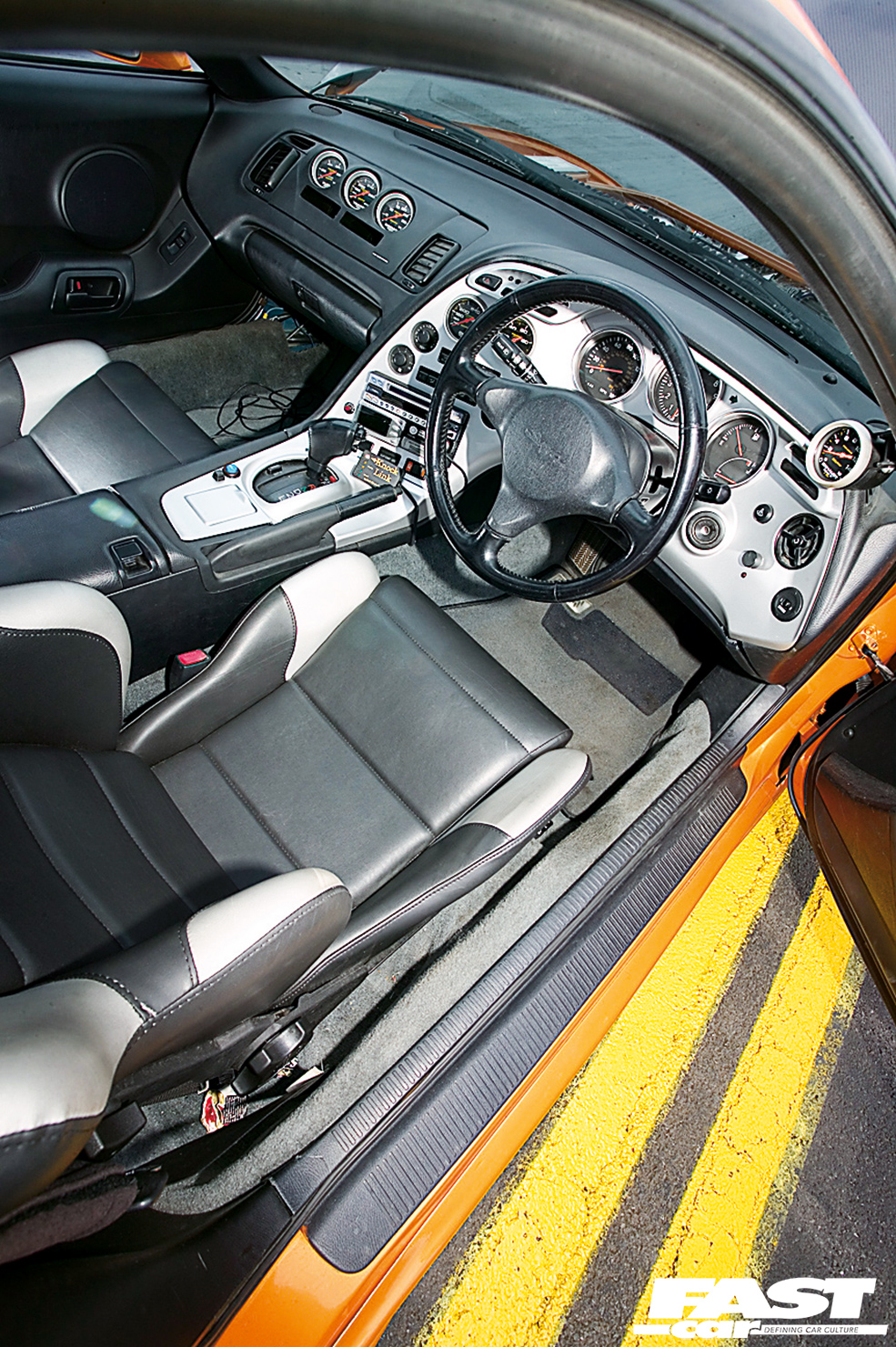
Keeping the Mk4 Supra cool
To make the most of these turbochargers, Leon has fitted a host of supporting mods, and claims the key to sustained big power is to concentrate on the ‘flow’ through the engine, and on engine cooling. There are loads of JPS Motorsport fabricated heat shields throughout the engine bay. Leon had also performed a big-winged sump conversion, which drops down an inch and is wider than the OEM item, and all the water-cooling lines are aluminium and heat-wrapped. Even the fuel pumps sit underneath the car to keep them cool.
When air is sucked through the HKS filters into those super-efficient turbos, it’s sent down wide pipes to a custom JPS Motorsport intercooler setup. Leon has utilised a huge (and deep) Trust core, and combined them with his own end tanks and piping. Again, this is the third intercooler arrangement he’s used, and is perhaps one of the most extreme modifications on the car.
“I had to cut a six-inch section of the chassis out to make it fit. I thought about it for ages, but ultimately it needed doing,” Leon confesses. Now, two 70mm pipes deliver hot, compressed air in one side, with a single 100mm outlet flowing the cooler stuff through a monstrous 100mm throttle body and into a gorgeous Veilside inlet plenum.
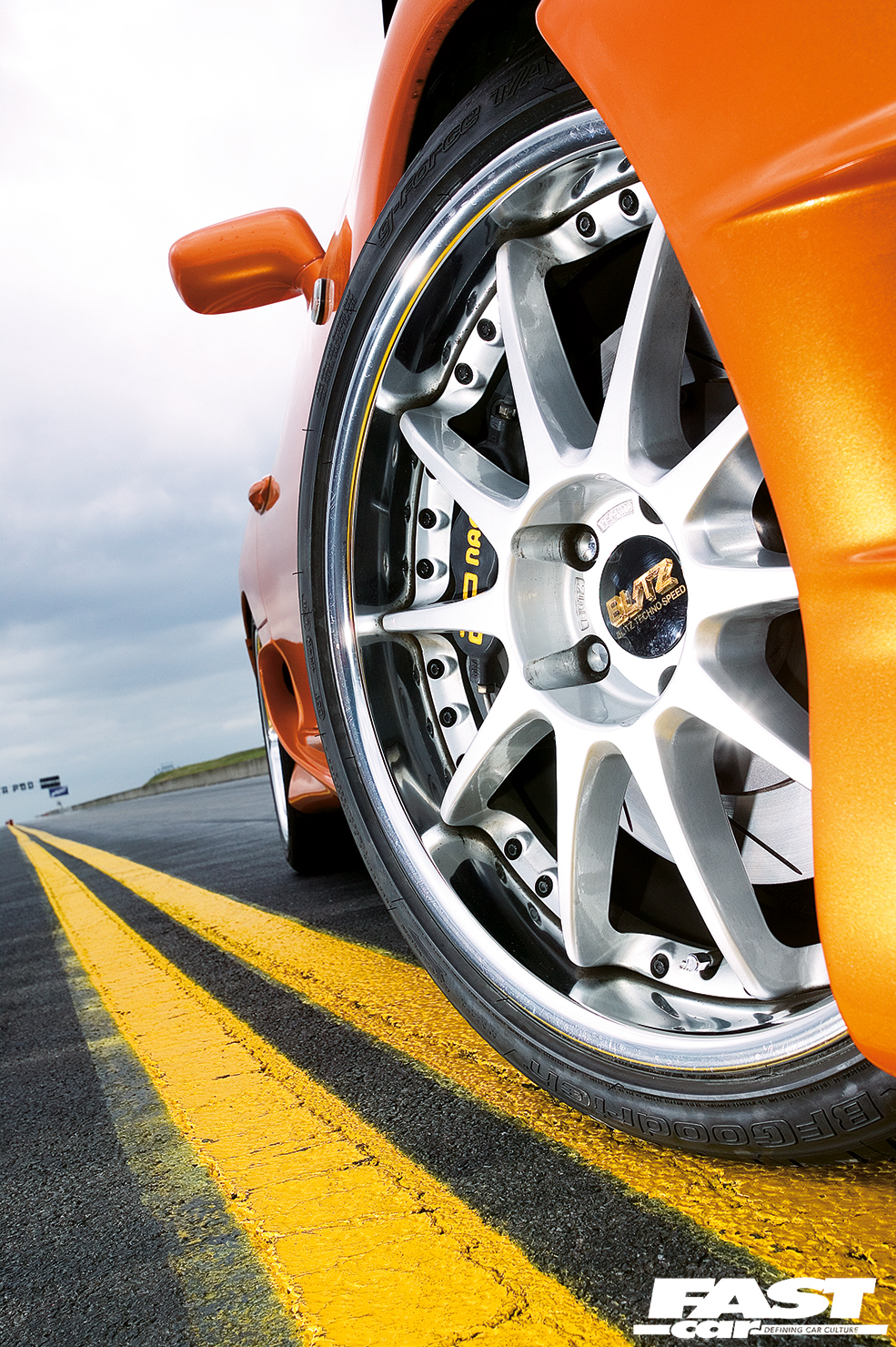
Supporting engine modifications on the Mk4 Supra
To match the large volume of air entering the cylinders, six HKS 1000cc injectors provide obscene amounts of fuel, mounted in a Veilside fuel rail. A JPS Motorsport ported and polished cylinder head then gets everything in and out as quickly as possibly with help from oversize Ferrera valves and HKS 272° camshafts. Obviously, all the internals are strengthened to cope, with forged pistons, H-section rods and modified crank all needed to take the stress. At a relatively modest 1.9bar of boost (approx 28psi), Leon’s brutal Supra forces 873bhp through the rear wheels, which is over 1000bhp at the flywheel.
Talking of stress, Leon has fitted an ATI front pulley dampener. He claims this is essential when running such a large engine spec, as it eases the imbalance often generated by hard-working engines, which could result in damaged bearings. It’s an approach he’s used throughout the build, concentrating on cooling and efficiency as much as ultimate horsepower. And believe me, when the result of all that engineering leaves through the Veilside titanium exhaust system, the noise is spectacular. After all of these years of constant evolution, Leon is in the position to finally break into the 9sec barrier. Will he do it? Of course he will. Stay tuned.
Do you love modified cars? Be sure to check out our Fast Car Events page to find out what event we’re hosting next!
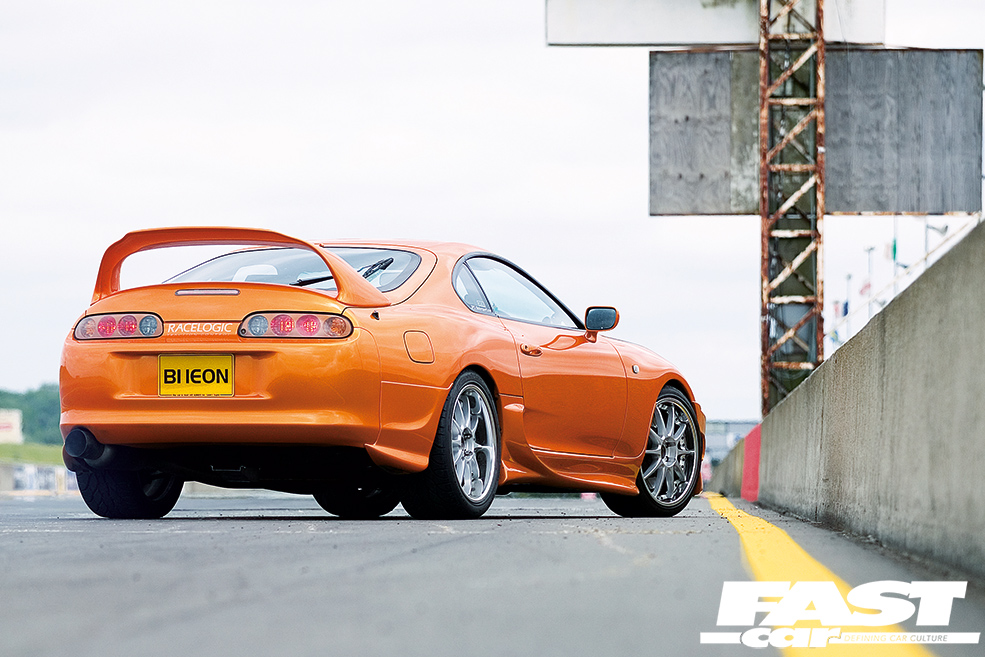
Tech Spec: 1050bhp Toyota Supra Mk4
Engine:
2JZ-GTE 3.0ltr straight-six twin-turbo; Autronic SM2 engine management; Autronic Direct Fire CDi 500R; HKS EVC boost controller; JE forged pistons; H-section con-rods; knife-edged and nitrated crank; ported and polished JPS Motorsport cylinder head with 1mm oversize Ferrera valves; HKS 272° cams with adjustable pulleys; HKS racing spark plugs; PWR aluminium radiator; JPS-Motorsport intercooler; Turbo Technics/JPS Motorsport development turbos; Veilside inlet plenum; 100mm throttle body; Veilside fuel rail; 6x 1000cc HKS injectors; ATI front pulley dampener; 2x HKS tubular manifolds; HKS downpipes; JPS Motorsport screamer pipes; Veilside titanium exhaust system; 2x Bosch Motorsport 044 fuel pumps.
Transmission:
JPS Motorsport modified auto ’box and clutch assembly; high-stall converter.
Suspension:
Tein adjustable coilovers for road; TRD front strut brace; JPS Motorsport rear strut brace; HKS drag suspension for competition events.
Brakes:
(f) AP Racing 6-pot calipers; 365mm grooved discs; JPS Motorsport braided lines; carbon metallic pads (Porterfield pads for ‘race’ and top speed runs); (r) JDM OEM discs and pads.
Wheels/Tyres:
Blitz Technospeed (f) 9×19 rims; (r) 10×19 rims; Goodrich G-Force T/A tyres; drag: Bogart 11 x 15in rims on rear with either BF Goodrich 275/50/15s or Mickey Thompsons where allowed.
Exterior:
Bomex front bumper; TRD carbon fibre vented bonnet; JDM-spec ’98 headlights; Veilside side skirts; JPS rear spoiler; Lamborghini Murcielago orange paint.
Interior:
Konig seats; Autometer gauges: fuel pressure; transmission temperature; boost pressure; EGT oil temp; oil pressure; TRD tachometer; blue nitrous purge button; Knock Link; HKS boost controller unit; Clarion headunit.
Words: Dan Goodyer. Photography: Simon Dodd.

